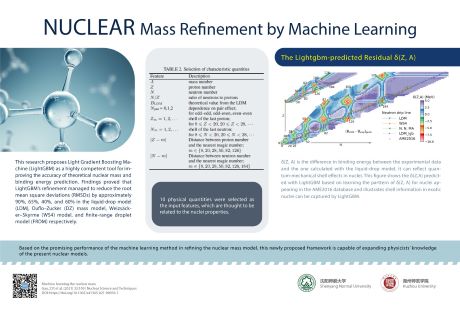博文
机器学习精确改进原子核质量
|
Article title: Machine learning the nuclear mass
文章标题:机器学习研究原子核质量
DOI: 10.1007/s41365-021-00956-1
One sentence summary:
一句话概要:
LightGBM is proven to be a highly efficient machine learning approach in obtaining a more precise nuclear mass.
LightGBM被证明是一种高效的机器学习方法,可以获得更精确的原子核质量。
http://www.nst.sinap.ac.cn/newsDetails/112/24749/en/

The Novelty (What)
创新性(主要内容)
Is there any room to increase the accuracy of theoretical nuclear mass prediction? This study demonstrated that Light Gradient Boosting Machine (LightGBM) is a highly competent tool for improving the accuracy of theoretical nuclear mass and binding energy predicted. With respect to experimental binding energy, LightGBM’s refinement managed to reduce the root mean square deviations (RMSDs) by approximately 90%, 65%, 40%, and 60% in the liquid-drop model (LDM), Duflo–Zucker (DZ) mass model, Weizsäcker–Skyrme (WS4) model, and finite-range droplet model (FRDM) respectively. Consistent RMSD improvement was obtained compared to the 66 newly measured nuclei that appeared in the new atomic mass evaluation, AME2020. Besides that, the LightGBM-refined mass models also yielded single and two-neutron separation energies values that matched those derived experimentally. All it took for the LightGBM to work was the input of characteristic quantities like mass and proton numbers. Relevance analysis of input characteristic quantities for each mass model was carried out using SHapley additive exPlanations (SHAP) and valuable results were obtained for future improvement and development of various nuclear mass models.
对原子核质量理论值预测的精确度还有增加的空间吗? 本研究表明,分布式梯度提升算法(LightGBM)是提高原子核质量(结合能)的理论值预测精度的有效工具。几种原子核质量模型,包括:liquid-drop(LDM)、Duflo-Zucker(DZ)、Weizsäcker-Skyrme(WS4)和finite-range droplet (FRDM),在经过LightGBM改进后其理论值与实验值的均方根偏差分别降低了90%、65%、40%和60%。在原子质量评估AME2020中66个新测量的原子核质量的预测值也有着不同程度的改进。 此外,由改进后的质量模型计算的单中子以及双中子分离能能够很好地符合实验值。 LightGBM工作所需要的只是输入质量数和质子数等特征量。 利用SHAP重要性特征解释方法对四种质量模型的输入特征量进行了相关性分析,得到了对核质量模型的改进和发展有价值的结果。
The Background (Why)
研究背景(主要原因)
Nuclear mass has been a crucial and challenging subject, especially for nuclei near the drip lines (i.e., the boundaries delimiting the zone beyond atomic nuclei decay). Several machine learning methods, such as Bayesian neural network (BNN) and Levenberg–Marquardt neural network (LMNN), are promising approaches for theoretical models to deduce nuclear mass with higher accuracy. On the other hand, a tree-based learning algorithm developed by Microsoft in 2016, known as LightGBM, shows upsides, including better learning capability, greater efficiency, and better accuracy. This puts LightGBM in an advantageous position to be applied in studies of nuclear mass. As an effort to verify the potentials of the LightGBM machine learning algorithm, this study deployed LightGBM in predicting the masses and binding energy of unknown nuclei. The reduced RMSDs obtained were an excellent validation of LightGBM’s value in nuclear mass studies, which could set a more refined direction for future research.
原子核质量一直是一个重要而又具有挑战性的课题,尤其是对于位于滴线附近的原子核。 贝叶斯神经网络(BNN)和Levenberg-Marquardt神经网络(LMNN)等几种机器学习方法是能够较好地对修正原子核质量理论模型。 另一方面,微软在2016年开发的一种基于树的学习算法LightGBM表现出更好的学习能力、更高的效率和更好的准确性。 这使得LightGBM在原子核质量的研究中具有一定的潜力。 为了验证LightGBM机器学习算法的潜力,本研究将LightGBM应用于未知原子核的质量和结合能的预测。 与实验间更小的偏差很好地验证了LightGBM在原子核质量研究中的价值,为今后的研究提供了更好的方向。
The SDG impact (Big Why)
SDG影响力(研究意义)
The advancement of astrophysics and nuclear physics correlates with the level of knowledge in nuclear mass. Hence, a highly efficient machine learning method is needed to speculate the masses of unknown nuclides, especially superheavy and neutron-rich nuclides. This study validated LightGBM’s potential in nuclear mass studies and, consequently, indicated the importance of machine learning in the progress of astrophysics and nuclear physics. These fundamental findings are essential to facilitate future scientific research by leveraging the ever-evolving technological capability, which aligns with the visions of UNSDG 9: Innovation, industry, and infrastructure.
天体物理学和核物理的发展与对原子核质量的认知息息相关。 因此,需要一种高效的机器学习方法来推测未知核素,特别是超重核素和丰中子核素的质量。 该研究验证了LightGBM在核质量研究中的潜力,从而表明了机器学习在天体物理和核物理发展中的重要性。 这些基本发现对于通过利用不断发展的技术能力促进未来的科学研究至关重要,这符合联合国可持续发展目标9的愿景:创新、工业和基础设施。
https://m.sciencenet.cn/blog-3474219-1366210.html
上一篇:用back-n中子束线改进重元素表征的有效方法
下一篇:聚变-蒸发反应中超重核119-122的合成